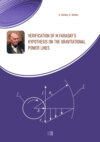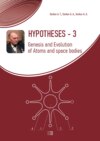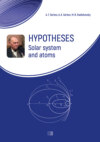Читать книгу: «Verification of M.Faraday's hypothesis on the gravitational power lines», страница 3
4. The influence of gravimagnetism on planetary and satellite distance
Let us consider the problem of the connection between phenomena gravimagnetism with the regularity of planetary and satellite orbital distances. Here it is appropriate to remind once again about the ideas of M. Faraday, who introduced the concept of the gravitational field, managing the planet in orbit. “The sun generates a field around itself, and the planets and other celestial bodies feel the influence of the field and behave accordingly."
Unlike the Moon, the Earth has its own rotation around its axis. This rotation may distort the lines of tension from Sinα = 1 to Sinα = 0, that is, braking force in a rotating central bodies can have a very small value.
It can be assumed that the rotation of the Earth causes deformation of the surrounding gravitational field, and this oscillatory motion, in which are formed of concentric layers with different orientation vector gravimagnetic tension. When the orientation is close to concentric (Sinα ≈ 0) the motion is without braking and energy consumption, i.e. elite or permitted orbits. If the orientation of the vector gravimagnetic tension is close to radial, as in the case of the Moon, the braking is happened and the satellite moves to the bottom of the orbit lying with less potential energy.
In some works [11, 12] it is shown that planetary and satellite orbital distance r is expressed by the equation similar to equation Bohr quantization of orbits in the atom:
r = n2k, (4)
where n is an integer (quantum) number, k is a constant having a constant value for the planetary and each satellite system.
The k values calculated for planetary and satellite systems, are presented in table 2. For different systems, while maintaining consistency within the system, the value of k varies within wide limits [13]. For the planetary system it is 6280.108 cm, and the smallest satellite system Mars 1,25.108 cm, there are 5 000 times smaller.
Seemed interesting to find such a mathematical model, which would be in the same equation was combined planetary and satellite systems. In this respect fruitful was the idea expressed by H. Alfvén [14], that “the emergence of an ordered system of secondary bodies around the primary body – whether it be the Sun or a planet, definitely depends on two parameters initial body: its mass and speed"… It has been shown [13] that when the normalization constant k in the complex, representing the square root of the product of the mass of the central body for the period of its rotation (MT)of 0.5, the result is a constant value, see table 2. If the constant k is changed for the considered systems within 3.5 decimal orders of magnitude, normalized by k/(MT)0.5 value saves the apparent constancy, rather varies from 0.95.10-8 to 1.66.10-8
Thus, in a mathematical model expressing the regularity of planetary and satellite distances should include the mass of the central body and the period of its rotation, two factors (mass movement) determining the occurrence of gravimagnetic forces in the system.
Further, in the synthesis equation, it seemed natural, should include the gravitational constant G. By a large number of trial calculations, it was found that equation (mathematical model) that combines planetary and satellite systems, is the expression:
r = n2(GMT/C)0.5, (5)
where n is the number of whole (quantum) numbers, C is a constant having the dimension of velocity, cm/s, see table 2.
Table 2. The values of the constants k and C

Consider in more detail and compare the constants C, included in gravimagnetic equation (1), (3) and equation (5). In both cases, the constants have the same dimension cm/s and approximate nearer value. The average value of the constants included in equations (3) and (5) respectively of 2.16.108 and 4,01.108 cm/s, We can assume that we are talking about the same dynamic gravitational constant, similar to the electrodynamics constant, i.e. the speed of light.
The overstated value of a constant, calculated according to equation (5) is connected with the incorrect definition of the period of rotation of the gas-liquid
central bodies for example, the rotation period of the Sun at the equator is equal to 25 days, and at high latitudes 33 days. It is clear that the inner layers and the entire body as a whole rotate at a higher speed. In accordance with the formula (5) this will lead to a lower constant value C.
The most accurate values are constants C values calculated for solid planets Earth and Mars, the period of rotation of which is determined accurately. The average value of the constants for these two planets is equal 2,48.108 cm/s, which almost coincides with the average value of the constant C = 2,16.108 cm/s, calculated by the formula (3) for satellites "the lunar Prospector", "Smart-1" and "Kaguya".
Thus, with a high degree of reliability can be argued that the constant C in equations (1), (3) and (5) are identical and express the same process gravimagnetic interaction of masses. In the first case the interaction is not rotating Moon and rotating around it satellites, in the second rotating central bodies (the Sun, planets) and their orbital bodies.
The results about gravimagnetism braking when the orbiting bodies driving around a non-rotating Central body – the Moon are in good agreement with the known data that celestial body which does not have its own rotation around its axis (Mercury) or low speed (Venus), do not have satellites. In contrast, satellites of rotating central bodies are braking poorly, especially when moving in orbits with a maximum shear strain of the gravitational field and, accordingly, with a peak concentric orientation of gravimagnetic power lines.
The bulk wave maximum deformation occurs at the equator and extends then in the equatorial plane. Captured satellites quickly decelerate and fall on the Central body. This explains the predominant position of the planets and satellites in the equatorial plane of a rotating central body. Here the greatest shear deformation and concentric orientation gravimagnetic field and the least resistance to movement of the orbital phone. For the same reason it is impossible the existence of polar satellites. Their orbit crosses the force lines at an angle close to 90°. Due to the high gravitational resistance, they quickly decelerate and fall.
A satisfactory explanation also receives the same direction of orbital motion with the rotation of the central bodies and synchronous rotation of the planets and the Sun.
Conclusions
1. The assessment of the gravity-magnetic effect by braking of the satellites of the Moon "Luna-10", "the lunar Prospector", "Smart-1", "Kaguya" and "Chandrayan-1 is given. For the quantitative description of effect used equation gravimagnetic braking similar electrodynamics equation of the Lorentz force and the equation of momentum. The constant part of the equation braking, has a value of C = 2,16.108 cm/s. Estimated time flight of satellites on orbit "the lunar Prospector", "Smart-1" and "Kaguya" is different from the actual ± 14 %.
2. On the basis of gravimagnetism braking orbital bodies is obtained the empirical formula, which expresses the dependence of the orbital planetary and satellite distances from a number of whole (quantum) numbers, mass and period of rotation of the central body. The formula is a constant having the dimension of velocity, equal for the solid planets C = 2,48.108 cm/s. Based on the mapping of constants in braking equation and in the formula of orbital distances the conclusion was made about the identity of these constants.
Литература
1. In Search of Gravitomagnetism, NASA's Gravity Probe B, http://science.nasa.gov/science-news/science-at-nasa/2004/19apr_gravitomagnetism/
2. W. Clifford, Washington University, The Search for Frame-Dragging, http://www.phys.lsu.edu/mog/mog10/node9.html3.
3. J.D. Anderson, Ph.A. Laing, E.L. Lau, A.S. Liu, M.M. Nieto, S.G. Turyshev, Indication, from Pioneer 10/11, Galileo, and Ulysses Data, of an Apparent Anomalous, Weak, Long-Range Acceleration, Phys. Rev. Lett. 81, 2858–2861 (1998).
4. Message TASS. A satellite in orbit around the moon. The first scientific results of the flight of the Moon-10, "Pravda", 100 No., 17417, Moscow, April 1966.
5. S. N. Kirpichnikov, Calculation of the motion of artificial satellites of the moon with regard to the radiation pressure of the Sun and Moon, Astronomical journal, so 45, No. 3, S. 675–685 (1968).
6. M. L. Lidov, M. C. Yarskaja, Integrable cases in the problem of the evolution of satellite orbits under the joint influence of the external body and decentralist field of the planet. Space research. 1974. T 12. No. 2. S. 155.
7. «Lunar Prospector»: http://nssdc.gsfc.nasa.gov/planetary/lunarprosp.html
8. «SMART-1»: http://www.esa.int/esaMI/SMART-1/index.html
9. «KAGUYA»: http://www.kaguya.jaxa.jp/index_e.htm
10. «Chandrayaan-1»: http://www.isro.org/chandrayaan/htmls/home.htm
11. A.M. Chechelnitsky, Horizons and new possibilities for astronautical systems megaspectroscopy, Adv. Space Res.,2002, v.29, № 12, p. 1917–1922.
12. F. A. Gareev, Geometric quantization of micro and macro systems. Planetary-wave structure of hadronic resonances, the Message of the joint Institute for nuclear research, Dubna, 1996, S. 296–456.
13. A. So Serkov, Space research,2009, T. 47, No. 4, S. 379.
14. H. Alfvén, H., Arrenius, Evolution of the Solar system, M., Ed. Mir, 1979, S. 14–15.
Chapter 3. The dependence of planetary and satellite distances from the speed rotation of the central bodies
Summary
In Chapter an attempt is made to determine in the equation of planetary and satellite distances the universal constant, which would unite planetary and satellite systems and allow with sufficient accuracy to calculate the elite orbit. To the solution of the problem has been approached through the use of complex representing the square root of the product of the mass of the central body of the system and the period of its rotation.
1. Introduction
The analysis of the dynamic structure of the Solar system, made in the work of B. I. Rabinovich [1], has brought to the fore the problem of stability of periodic motions in systems with commensurate frequencies, which are closely linked to the existence of elite orbits in planetary and satellite systems. A priority issue in this problem is the establishment of the laws of planetary and satellite distances. The author prefers the proposal made earlier by A. M. Chechelnitsky [2], according to which the radii of the elite orbits of planets and satellites Rn determent by quartos law:
Rn = k n2, (1)
where k is a constant and n is an integer number that determines the position of the elite orbit.
The proposed law, in contrast to empirical rules Titius-Bode [3] more accurately describes the dependence of planetary and satellite distances for all systems. In addition, it allows detecting the quantum properties of the gravitational planetary systems.
On this occasion, F. A. Gareev writes [4]: "In the framework of the considered model it is possible to conclude that in the Solar system quanthouse sectorial and orbital velocity and orbital distances of the planets and their satellites". The author on the basis of the equation (1) for planetary and satellite systems received constant (h/mG) is the quantum double sectored speed. The value of this constant for the different systems is presented in table 1. According to the author's constant satisfactorily within ±5 % remains constant for the same system. However, between the difference reaches 5 decimal orders of magnitude.
Table 1. The values of the constants (a/mG) for planetary and satellite systems and its relationship with the rotation parameters of the Central bodies systems.

This article in the framework of representations arising from law formulated in equation (1), an attempt is made to establish a universal constant, which would unite planetary and satellite systems. When this work has taken into account the statement of Alven H. [5], "the emergence of an ordered system of secondary bodies around the primary body – whether it be the Sun or a planet, definitely depends on two parameters initial body: its mass and speed".
2. Orbital distance for satellite systems
To establish the relationship between constant k and rotation parameters of the central bodies of planetary and satellite systems were calculated constants for planetary systems, and systems of Jupiter, Saturn, Uranus and Neptune. Table 2 shows the calculated values of k, for the planetary system, calculated by equation (1). The values of n for the calculation were taken from the work of F A. Gareev. The obtained average value of the constants k= 6,28∙1011 cm with standard deviation of 0.49∙1011 cm. Also the dependence of planetary distances from the squares of integers represented in Fig. 1, which confirms the correctness of the values of the integer n.

Fig.1. The dependence of the orbital distances rn in the planetary system from squares of integers n
Table 2. The values of the constant k in equation (1) for the planetary system.

Similar calculations were done for the satellite systems of Jupiter, Saturn, Uranus and Neptune. In table 3 and Fig.2 shows the data for the satellite systems of Jupiter. The system has 63 satellites. Many rely on close orbits and were therefore combined into groups. For example, in orbits with an average distance 23813∙108 cm turns 28 satellites. All of them are given one quantum number 29.
In the system of Jupiter are 32 elite orbits, which are comparable with the planetary system, where they are 30. The constancy of the constants k observed satisfactorily for all orbits except the first two quantum numbers 2 and 3. The average value of the constants k = 28,6∙108 cm with standard deviation of 0.3∙108 cm excluding the first two orbits, deviations from which are outside the statistical sample. The dependence of the orbital distances in the satellite system of Jupiter is given also in Fig.2.
Graph expressing this dependence was used to determine the values of the quantum numbers n. All experimental points, expressing the satellite or group of satellites with the same orbital distances satisfactorily fit to a straight line, as required by equation (1). Each orbital distance on the ordinate corresponds to the value of n2 on the abscissa.

Fig. 2. The dependence of the orbital distances rn in the system of Jupiter from squares of integers n.
Таблица 3. The values of the constant k in equation (1) for the system of Jupiter.

Table 4 presents data calculation constants k for the satellite system of Saturn. In the Saturn system there are only 47 satellites that turn on 39 elite orbits. Many of them come in close orbits. Therefore, just as in the case of Jupiter it is, they are combined into a one single orbit with one quantum number. The average value of the constants k = 14,7∙108 cm with standard deviation of 0.14∙108 cm.
Table 4. The value of the constant k for a system of satellites of Saturn

The dependence of the satellite orbital distances from the squares of integers for a system of Saturn is shown in Fig. 3. In accord with equation 1 there is a linear relationship between these quantities.

Fig.3. The dependence of the orbital distances rn in the Saturn system from squares of integers n.
The results of the calculation of the constant k for the satellite system of Uranus are summarized in table 5. The average value of a constant is equal to 11.8∙108 cm with standard deviation of 0.11∙108 cm. At the calculation was not considered abnormally high value when n =2, which is outside the statistical sample. A similar phenomenon was observed when considering the system of Jupiter.
To eliminate abnormally high values of k for small n an attempt was made to modify the formula (1) by introducing into the equation an additional term, which on the ordinate axis was cut off for a certain period, and k values decreased. However, at this stage, a positive resolution of this issue could not be reached.
Graphic image of orbital satellite distances from the n2 for Uranium system is expressed by a straight line passing through the origin of coordinate with a small deviation for small values of n, see Fig. 4.

Fig.4. The dependence of the orbital distances rn in the system Uranium from squares of integers n.
Table 5. The value of the constant k for a system of satellites of Uranus.

For satellite systems Neptune observed a similar picture. In total, the system has 13 satellites. Estimates of the constant k and the quantum numbers n are presented in table 6 and in Fig. 5. The constant k without taking into account the group of the first four satellites has an average value 9,85∙108 cm with standard deviation of 0.11∙108 see.
As in the previous cases, the first elite orbits are observed slightly overestimated values of the constants that should be the subject of additional studies. It should also be noted overestimated in comparison with other systems the number of elite orbits – 71. The Sun, Jupiter, Saturn and Uranus has respectively 30, 32, 39 and 42. This may be due to a large distance from the Sun.
Table 6. The value of the constant k for a system of Neptune satellites.


Fig.5. The dependence of the orbital distances rn in the system of Neptune on squares of integers n.
Taking into account the opinion of Alven H. [5] about the dependence of order of the gravitational planetary systems on the rotation parameters of their central bodies, an attempt was made to establish the relationship between these parameters and the constant k in equation (1). After a large number of exploratory
calculations, it was found that the most adequate for all systems the dependence of the constant k on the mass M and the rotation period T of the central bodies is expressed through the square root of the product of these quantities, i.e., through (MT) 0.5.
In other words the individual for all the considered systems, the constant k when divided by complex (MT)0.5 to be invariant under all systems:
k = φ(MT)0.5, (2)
where the constant φ is constant for planetary and all satellite systems.
This is confirmed by the results of the calculation are given in table 7. The ratio k/(MT)0.5 (constant φ) varies from 0.95∙10-8 to 1.61∙10-8 cm/g 0,5∙s0,5, while the constant k, respectively, in the range from 9,85∙108 to 6280∙108 cm. Thus, we can assume that the constant k and, accordingly, planetary and satellite distances rn really depend on the parameters of the rotation of the central bodies, their mass and the rotation period. And this dependence is adequately expressed by the formula (2).
Table 7. The relationship between the constant k and the rotation parameters of the central bodies of planetary and satellite systems.

Some inconstancy φ (standard deviation reaches of 0.12∙10-8 with an average value of 1.2∙10-8 cm/g0.5s0,5, (coefficient of variation equal 10 %.), apparently, due to the fact that in the calculations used the reference values of the periods of rotation of the liquid-gas central bodies, which are determined by moving their surface layers. Then as in the formula (2) by definition, refers to the rotation of the central body as a whole.
Only solid planet Earth and Mars have the exact value of the rotation period as a whole. But a satellite systems of these planets are not developed and does not allow sufficient accuracy to determine the constant k, and calculate the rotation parameters true value of a constant φ. Nevertheless, with that said the quantitative dependence of the orbital distances, expressed by equations (1) and (2) seems to be quite probable.
In conclusion, let us compare the results obtained in this article with the data of F.A. Gareev [4], which are shown in table 1. As already noted, they were received of the quantum constant, stable consistency within individual systems, but very different (5 orders of magnitude) between systems. It turned out that the quotient of these constants proposed in this work ин complex (MT) 0.5, taking into account the mass and the speed of rotation of the central body has an approximately constant value, see table 1. Its average value 0,065∙10-22, with standard deviation 0,026∙10-22 km∙g-0,5/s-1,5.
Thus, the proposed complex, which represents the square root of the product of mass on the period of rotation of the central body can be considered as universal, allowing you to compare (simulate) all satellite and planetary systems.
Бесплатный фрагмент закончился.
Начислим
+3
Покупайте книги и получайте бонусы в Литрес, Читай-городе и Буквоеде.
Участвовать в бонусной программе

















